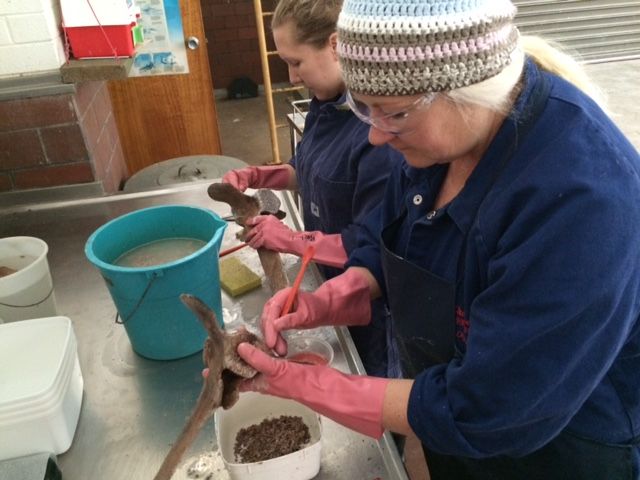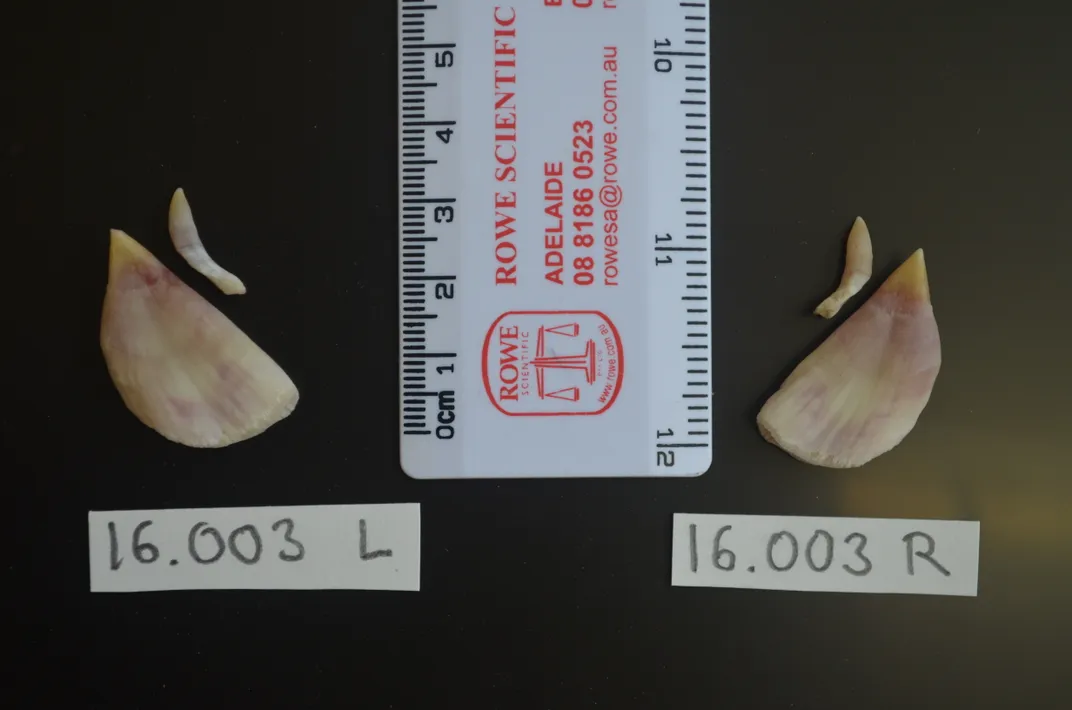Rare Beaked Whale Washes Ashore in Australia
Sporting unusual teeth, the young female offers researchers a chance to study an elusive cetacean
/https://tf-cmsv2-smithsonianmag-media.s3.amazonaws.com/filer/5f/44/5f445e5d-2fab-4078-bb54-8cb9552c930e/dsc_0003_beaked_whale_swebster_30-1-16.jpg)
When a young female whale washed ashore near the town of Victor Harbor in South Australia, researchers were called in to examine the body. The experts from the South Australian Museum in Adelaide quickly deduced that the mammal was a beaked whale—presenting them with an exciting opportunity for study since cetaceans in this family aren't well understood.
But then they spotted something that made them even more excited.
"As we were doing the dissection, after we'd done our measurements and photos, we started to the look at the jaws because that's one of the distinctive parts of a beaked whale," senior research scientist Catherine Kemper tells Tom Fedorowytsch of ABC News. The young female had two small, pointy teeth poking above the jawline. "They were very odd. I didn't know what it was, because these teeth were something I had never seen before." At first, she thought they might have a new species on their hands.
The museum team took the whale carcass back to the museum where they had a special set up to clean the flesh from the bones that relies on warm vats of bacteria-filled water. They were used to dealing with whale bodies, after the animals wash ashore or strand—something that can happen when cetaceans are sick or injured but also for other, unknown reasons.

Under the small teeth, collections manager David Stemmer found bigger, triangular teeth typical of a type of beaked whale called Hector's beaked whale. In females of that species, the teeth don't erupt above the gums. But this one had the two extra, smaller teeth atop the ones hidden in her jaw.
The unusual teeth "may be what’s called an atavism, where traits reappear that have disappeared generations before," Kemper writes to Smithsonian.com. "They indicate that beaked whale ancestors had more teeth."
Next, they hope to run genetic tests and confirm that the whale is a Hector's as well as to compare the genetic material to other species found elsewhere in the southern hemisphere.

"[Although] we now knew we had a species we know, it's a species we don't get very often and it's only the third specimen we have collected here in South Australia," Stemmer tells ABC News.
Of 22 species in the beaked whale family, eight have been spotted in South Australia waters, reports Amelia Broadstock for The Advertiser.
Some species can dive to more than 2,600 feet below the surface and stay in the depths for up to 87 minutes, writes Becky Crew for Scientific American. She adds, "we have frustratingly few records" for many of these species. Most of what scientists do know comes from strandings like this one.
As a result, beaked whales are "one of the most specialized and least understood of all the mammal groups," according to The Beaked Whale Resource. Some of their interesting features are adaptations for their deep dives that they share with other species: blood that can carry more oxygen, a circulation system that shuts down supply to certain organs so that the oxygen can go where it's most needed. But others are more unique:
We know of some other weird and wonderful adaptations such as a specialized throat structure to allow strong sucking, teeth that are good for fighting over mates but nothing else, and pockets to tuck flippers into to swim more efficiently, others we can only guess at. Why have the densest bones of any mammal? Why have 13 stomachs?
Like other members of the family, Hector's beaked whales presumably live off squid and deep-sea fish. They're considered denizens of cool waters in the Southern Hemisphere, off the coasts of South America, South Africa, southern Australia and New Zealand. When full grown, they can reach up to 13 feet in length and weigh around a ton, supplies The Beaked Whale Resource. They have light grey heads and dark grey bodies.
“We unfortunately have no idea how many there are out in the ocean because they are hard to see,” Kemper tells The Advertiser. The International Union for the Conservation of Nature (IUCN)'s Red List of Threatened Species categorizes them as data deficient. “There is still a lot we can learn from this animal," she adds.
There is evidence that noise from human activities can disrupt deep-diving whales and even lead to their deaths. Kemper writes, "The more we know about where those whales are and when, the better chance we have of not having negative impacts on them."
/https://tf-cmsv2-smithsonianmag-media.s3.amazonaws.com/filer/62/ba/62bad6c2-dcc2-46ff-bd32-619bc5900a06/img_1536.jpg)